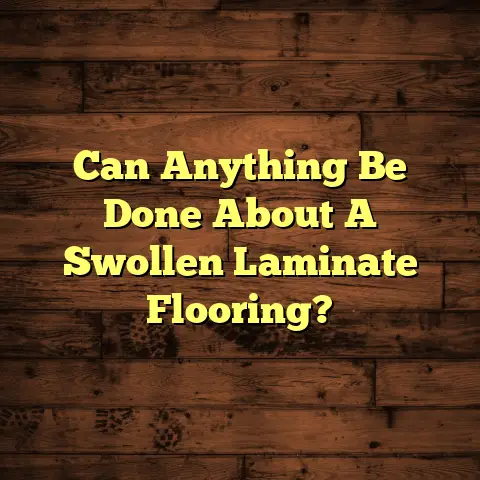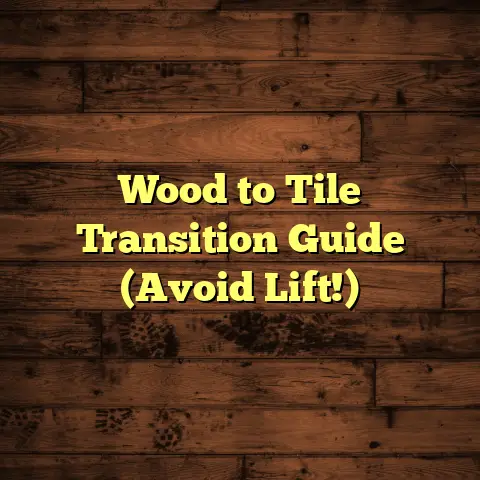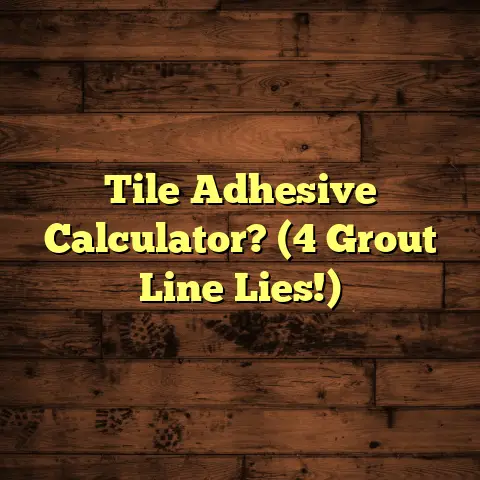Cover Outdoor Concrete Cheap (4 DIY Tricks!)
I get it. You’re staring at that drab, cracked, and frankly depressing concrete patio, and you’re dreaming of a backyard oasis. But the thought of a full-blown renovation makes your wallet weep.
Don’t despair! I’ve been in the flooring game for over 15 years, and I’ve seen it all. I know how to transform outdoor spaces on a budget. Forget jackhammers and expensive contractors. I’m going to share four DIY tricks to cover that ugly concrete cheaply and turn your backyard into a place you actually want to hang out in.
Ready to get started? Let’s dive in!
Section 1: Understanding the Challenges
of Outdoor Concrete
Let’s face it, outdoor concrete takes a beating. It’s exposed to the elements 24/7, 365 days a year. Sun, rain, snow, ice – it all takes its toll. Over time, you’ll likely encounter:
-
Cracks: These can range from hairline fractures to major fissures. Temperature fluctuations and ground movement are usually the culprits.
-
Stains: Oil spills, rust, mildew, and fallen leaves can all leave unsightly marks.
-
Weathering: The surface can become pitted, faded, and generally worn down over time.
These issues not only detract from the aesthetic appeal of your outdoor space, but they can also affect its functionality. Cracked concrete can be a tripping hazard, and a stained patio is just plain uninviting.
According to a 2023 survey by the National Association of Realtors, outdoor living spaces are a top priority for homebuyers. Investing in your patio or deck can significantly increase your home’s value and appeal. But don’t worry, you don’t need to spend a fortune!
My goal is to show you affordable and effective ways to improve the look and functionality of your outdoor concrete, so you can enjoy your backyard without breaking the bank.
Section 2: Trick #1 – Paint Your Concrete
Painting your concrete is one of the most cost-effective ways to dramatically improve its appearance. A fresh coat of paint can hide stains, cover minor cracks, and add a pop of color to your outdoor space.
Here’s a step-by-step guide:
1. Choose the Right Concrete Paint:
-
Acrylic Latex Paint: This is a popular choice because it’s durable, water-resistant, and easy to apply. Look for paints specifically formulated for concrete surfaces.
-
Epoxy Paint: Epoxy is even more durable than acrylic latex and provides excellent resistance to chemicals and abrasion. However, it can be more expensive and requires more careful preparation.
-
Concrete Stain: If you want to maintain the natural look of the concrete while adding color, consider using a concrete stain. Stains penetrate the surface and won’t peel like paint.
Pro-Tip: I always recommend checking the paint’s VOC (Volatile Organic Compound) content. Opt for low-VOC or zero-VOC paints to minimize harmful emissions.
2. Prepare the Surface:
This is the most crucial step! A poorly prepared surface will result in a peeling, flaking paint job.
-
Clean: Thoroughly clean the concrete using a pressure washer or a scrub brush and a concrete cleaner. Remove all dirt, grease, oil, and loose debris.
-
Repair Cracks: Fill any cracks or holes with a concrete patch compound. Let it dry completely according to the manufacturer’s instructions.
-
Etch (Optional): If your concrete is very smooth, you may need to etch it with a concrete etching solution to improve paint adhesion. Follow the etching solution’s instructions carefully.
-
Prime: Apply a concrete primer to the surface. Primer helps the paint adhere better and provides a uniform base.
3. Paint the Concrete:
-
Apply the Paint: Use a roller or a brush to apply the paint in thin, even coats. Follow the manufacturer’s instructions regarding drying time between coats. I usually recommend at least two coats for optimal coverage and durability.
-
Consider Patterns: Get creative with your paint job! You can use stencils to create patterns, paint a faux tile design, or even create a checkerboard effect.
4. Ensure Durability:
-
Seal: Apply a concrete sealer to protect the paint from the elements and prolong its lifespan. Reapply the sealer every year or two.
-
Avoid Harsh Chemicals: Don’t use harsh chemicals or abrasive cleaners on the painted surface.
Color and Pattern Ideas:
-
Neutral Tones: Grays, beiges, and tans create a classic and sophisticated look.
-
Bold Colors: Blues, greens, and reds can add a vibrant and playful touch.
-
Geometric Patterns: Stripes, chevrons, and geometric shapes can add visual interest.
-
Faux Tile: Paint a tile pattern to mimic the look of expensive tile flooring.
Painting my own patio with a stencil pattern transformed it from an eyesore into a focal point. It cost me less than $100 in materials and a weekend of work!
Section 3: Trick #2 – Use Outdoor Rugs
Outdoor rugs are a fantastic way to cover unsightly concrete quickly and easily. They can instantly add warmth, color, and texture to your outdoor space. Plus, they’re super versatile and can be moved around as needed.
Types of Outdoor Rugs:
-
Polypropylene Rugs: These are the most popular choice for outdoor rugs because they’re durable, water-resistant, and easy to clean.
-
Polyester Rugs: Polyester rugs are also durable and water-resistant, but they may not be as fade-resistant as polypropylene.
-
Natural Fiber Rugs: Jute, sisal, and bamboo rugs can add a natural and rustic touch to your outdoor space. However, they’re not as water-resistant as synthetic rugs and may require more maintenance.
Selecting the Right Size and Style:
-
Size: Choose a rug that’s proportional to your outdoor space. A rug that’s too small will look lost, while a rug that’s too large will overwhelm the area.
-
Style: Consider your existing outdoor decor when choosing a rug style. A geometric rug can add a modern touch, while a floral rug can create a more romantic feel.
Placement Ideas:
-
Under Furniture: Place a rug under your outdoor furniture to define the seating area.
-
As a Runner: Use a runner rug to add color and pattern to a narrow patio or balcony.
-
Layering: Layer multiple rugs to create a cozy and inviting atmosphere.
Securing Rugs in Windy Conditions:
-
Rug Pad: Use a non-slip rug pad to prevent the rug from sliding around.
-
Outdoor Tape: Secure the corners of the rug to the concrete with outdoor tape.
-
Furniture: Place heavy furniture on the edges of the rug to weigh it down.
I once helped a client transform her bare concrete balcony into a cozy reading nook simply by adding a large outdoor rug, a comfortable chair, and some potted plants. The transformation was incredible!
Section 4: Trick #3 – Create a Wood Deck
Overlay
Building a simple wood deck overlay is a more ambitious project, but it can completely transform your outdoor concrete into a beautiful and functional space. A wood deck adds warmth, texture, and a more comfortable surface underfoot.
Materials:
-
Pressure-Treated Lumber: Use pressure-treated lumber for the deck frame and decking boards. This will protect the wood from rot and insect damage.
-
Deck Screws: Use deck screws to secure the decking boards to the frame.
-
Construction Adhesive: Use construction adhesive to further secure the decking boards to the frame and prevent them from squeaking.
Tools:
- Measuring Tape
- Saw
- Drill
- Screwdriver
- Level
Construction Guide:
-
Measure the Concrete: Measure the area you want to cover with the deck overlay.
-
Build the Frame: Build a frame using pressure-treated lumber. The frame should be slightly smaller than the concrete area to allow for expansion and contraction.
-
Install the Decking Boards: Cut the decking boards to size and attach them to the frame using deck screws and construction adhesive.
-
Sand and Seal: Sand the deck surface to smooth out any rough edges. Apply a deck sealer to protect the wood from the elements.
Benefits of a Wood Deck:
-
Aesthetics: A wood deck adds warmth and natural beauty to your outdoor space.
-
Comfort: Wood is more comfortable to walk on than concrete, especially on hot days.
-
Value: A well-built deck can increase your home’s value.
Safety Tips:
-
Wear Safety Glasses: Always wear safety glasses when cutting and drilling wood.
-
Use Proper Tools: Use the right tools for the job and follow the manufacturer’s instructions.
-
Build a Sturdy Frame: Make sure the deck frame is strong and stable.
Maintenance Advice:
-
Clean Regularly: Clean the deck regularly with a deck cleaner to remove dirt and debris.
-
Re-Seal Annually: Re-seal the deck annually to protect the wood from the elements.
I built a simple wood deck overlay on my own patio a few years ago, and it completely transformed the space. It’s now my favorite place to relax and entertain guests.
Section 5: Trick #4 – Install Interlocking Pavers
Interlocking pavers are another great way to cover outdoor concrete and create a more visually appealing surface. Pavers come in a variety of styles, colors, and patterns, allowing you to customize your outdoor space to your liking.
Installation Guide:
-
Prepare the Concrete Surface: Clean the concrete surface thoroughly. Repair any major cracks or damage.
-
Lay a Bedding Layer: Spread a thin layer of sand over the concrete surface. This will provide a level base for the pavers.
-
Arrange the Pavers: Arrange the pavers in your desired pattern. Use a rubber mallet to gently tap the pavers into place.
-
Fill the Joints: Fill the joints between the pavers with sand. Sweep the sand into the joints using a broom.
Variety of Paver Styles:
-
Concrete Pavers: Concrete pavers are durable, affordable, and come in a wide range of colors and styles.
-
Brick Pavers: Brick pavers add a classic and timeless look to your outdoor space.
-
Stone Pavers: Stone pavers are a more expensive option, but they offer a natural and elegant look.
Additional Benefits:
-
Improved Drainage: Pavers allow water to drain through the joints, preventing puddles and slippery surfaces.
-
Easy Replacement: If a paver becomes damaged, it can be easily replaced without having to replace the entire surface.
I helped a client install interlocking pavers on her concrete driveway, and it completely transformed the curb appeal of her home. The pavers added a touch of elegance and sophistication that the plain concrete driveway lacked.
Section 6: Conclusion
So there you have it – four DIY tricks to cover outdoor concrete cheaply and transform your backyard into a space you’ll love.
Let’s recap:
-
Paint Your Concrete: A cost-effective way to add color and cover stains.
-
Use Outdoor Rugs: A quick and easy way to add warmth and texture.
-
Create a Wood Deck Overlay: A more ambitious project that adds warmth and comfort.
-
Install Interlocking Pavers: A durable and customizable option that improves drainage.
I encourage you to take on one of these projects and see the difference it can make in your outdoor space. Not only will you beautify your home, but you’ll also create an inviting environment for gatherings, relaxation, and making memories with family and friends.
Don’t let that ugly concrete hold you back any longer. Get out there and transform your backyard into the oasis you’ve always dreamed of! You got this!





